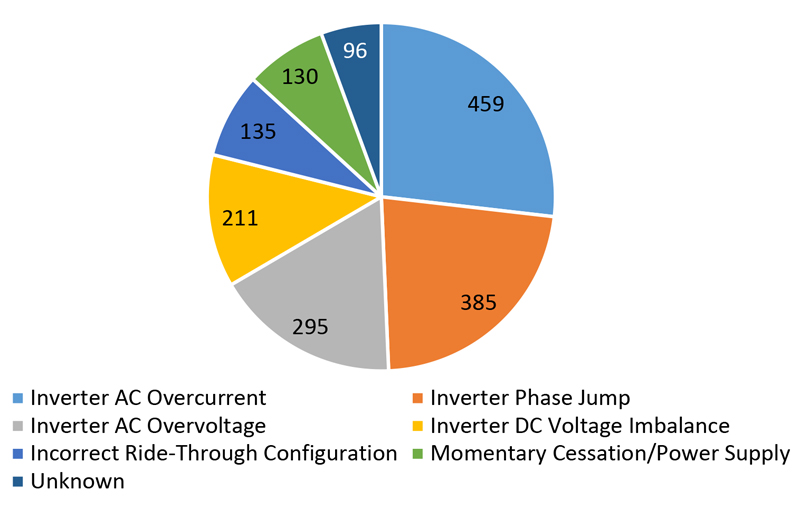
Addressing the performance issues of inverter-based resources (IBR) has become a “paramount” priority for the ERO, according to a new analysis of yet another IBR-related service disruption released Thursday by NERC and the Texas Reliability Entity.
The report covers the June 4, 2022, disturbance, when the Texas interconnection lost 2,555 MW of solar PV and synchronous generation near the town of Odessa. NERC has dubbed the event the 2022 Odessa disturbance to differentiate it from a similar event that happened just over a year earlier in the same location, which led to a total reduction in output of 1,340 MW. (See NERC-ERCOT Report Reviews Texas Solar Issues.)
Noting the resemblance between the two incidents, the report’s authors called for “immediate industry action” to ensure that IBRs do not pose a threat to grid reliability, a sentiment echoed by NERC CEO Jim Robb on social media.
“Enough evidence already!” Robb said in a retweet of the official NERC Twitter account’s post announcing the new report. “Time to move forward to develop the requirements to stop these inverter-based events. Inverter-based resources are a key part of the grid and will continue to grow and they will be developed and modeled in a way which supports reliability!”
Lightning Arrestor Triggers Resource Trips
The disturbance began at 12:59 p.m. when a lightning arrestor failed at a synchronous generation plant near Odessa, causing a B-phase-to-ground fault on the 345-kV bus. This fault was cleared by protective relaying in about three cycles; meanwhile, generator protection on a neighboring unit misoperated because of current transformer saturation, causing additional generation to trip and runback.
In all, 844 MW of synchronous generation tripped in the Texas RE footprint: 535 MW at the first location and an additional 309 MW at a synchronous generation plant in South Texas that tripped because of loss of excitation caused by an automatic voltage regulator that was in manual mode instead of automatic. In addition, 1,711 MW of solar PV generation — more than twice as much — was lost, much of it from large, grid-connected facilities in the West Texas footprint.
 Causes of solar PV reduction | NERC
Causes of solar PV reduction | NERCAccording to the report, most of the solar PV sites that responded abnormally to the disturbance in 2022 did so in the 2021 Odessa event as well. Inverter instantaneous AC overcurrent was identified as the leading cause of reduced output in 2022 at 459 MW, followed by inverter phase jump with 385 MW. Neither of these was listed as a cause of reductions in 2021. At the time of the 2022 disturbance, solar PV output made up about 16% of ERCOT’s resource mix, while wind accounted for about 10%; the rest was composed of synchronous generation.
In their analysis, NERC and Texas RE observed that of the solar facilities involved in the 2021 disturbance, only one “was able to deploy mitigating actions between events that resulted in appropriate ride-through performance” in the 2022 event. Although several of the others did implement various changes intended to prevent the causes of reduction in 2021, they suffered reductions for other reasons in the second event. (One made no changes and was not involved in the 2022 disturbance.)
The report noted that some facilities that tripped because of PLL loss of synchronism or inverter AC overvoltage protection in 2021, tripped on voltage phase jump in 2022, indicating that “any one of multiple layers of protective functions within the inverter can result in tripping.” Additionally, changes intended to prevent unnecessary feeder-level tripping that occurred in 2021 led to the same facilities falling victim to inverter-level protection and control issues in 2022.
Stakeholder Steps
As with the previous Odessa disturbance, the report’s authors provided a number of recommendations for NERC, FERC, ERCOT, utilities and other stakeholders.
First on the list was to update NERC’s reliability standards to address gaps in the performance of IBRs. Among the changes needed is a ride-through standard to replace PRC-024-3 (Frequency and voltage protection settings for generating resources). After the 2021 disturbance, NERC’s Project 2020-02 (Modifications to PRC-024) added the issue of IBR performance to its remit. The report said the 2022 event had driven home the “importance of enhancing this standard to a comprehensive ride-through standard.”
The report also noted the standard authorization request (SAR) developed by NERC’s Inverter-based Resource Performance Subcommittee that would require owners of IBRs to “identify, analyze and mitigate any identified abnormal performance issues.” The authors said that NERC “strongly recommends” the SAR be fast-tracked “to get mitigations in place as quickly as possible.”
Next, the report said that NERC will issue an alert to provide generator owners (GO) with recommendations for possible performance mitigations while the standards are being developed. A second alert will “ensure that all GOs of [IBRs] provide adequate proof that the dynamic models match actual equipment controls, settings and protections.” GOs will be required to report any discrepancies to the ERO Enterprise, along with transmission planners and planning coordinators, to ensure corrective actions are implemented.
Recommendations to GOs, generator operators (GOP), transmission owners and equipment manufacturers include checking their dynamic models to ensure accuracy and implementing regular validation processes while adopting applicable NERC reliability guidelines. For FERC, the report advises improving the “generator interconnection procedures and agreements to address issues pre-commissioning” that are not covered by NERC’s standards.
Finally, the report recommends that ERCOT “continue its strong stakeholder outreach and education program” to GOs and GOPs of IBRs to ensure they are implementing appropriate mitigation actions and conduct a system model validation effort to “ensure that those models reflect as-commissioned equipment settings and can accurately recreate system events.”


